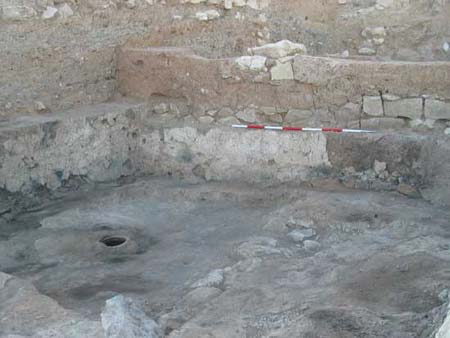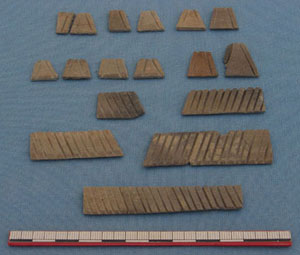The Middle Bronze Age (2000-1600 BC)
During the Middle Bronze Age the Euphrates south of Karkemish was border between the kingdom of Jamhad with its capital Halab (modern Aleppo) in western Syria, and Mesopotamian kingdoms to the east. During a brief period in the 18th cent. BC all of northern Mesopotamia was united under the mighty king Shamshi-Adad I, who ruled a kingdom stretching from the Iranian mountains to the Euphrates. Written sources provide accounts of confrontations between Shamshi-Adad and the king of Jamhad, Sumu-Epuh, and of forts on the Euphrates which were established, lost – and reconquered.
Aushariye may have been one of these forts, known as Dur-Shamshi-Adad or Dur-Sumu-Epuh (dur means “fortress” in the ancient Akkadian language – and the rest of the name depended on which of the two rivals held the place).
In Area G at the southwestern corner of Aushariye excavation has uncovered 3 different levels dating to the Middle Bronze Age. In the oldest Level VIII are remains of an enceinte built of mud bricks on limestone footings. Associated ceramics and other finds show that it probably dates to the early part of the period (ca. 2000-1900 BC).

Area G with the enceinte VIII visible in the middle of the picture.
The Level VIII enceinte was badly damaged by massive stone foundations for a terrace founded in the subsequent Level VII, and which have also been found in other places on the plateau edge. This construction, which no doubt was intended to support a new enceinte, represents a considerable effort. Since only foundations survive it is not easy to date the construction precisely, but the subsequent Level VI belongs in the 17th cent. BC, and accordingly the terrace must date to the period between ca. 1900-1700 BC.

Foundations for the stone terrace in Area G, Level VII.
We do not yet know what happened with the terrace. Possibly the construction was never finished to plan, maybe it was abandoned and eroded – or perhaps it was destroyed deliberately. In any case the foundations were reused by the people in the subsequent Level VI, who built houses slightly into the foundations. In 2004 we excavated some rooms in this level and they had clearly been destroyed by fire. In the rooms were many ceramic vessels crushed by collapsed walls and charred roof beams. Especially one room was full of finds: ceramics, stone tools, and other objects. The ceramics are very characteristic for the latest part of the Middle Bronze Age, and can be dated fairly accurately by parallels elsewhere to the 17th cent. BC.

Burnt room (locus G1A) in Level VI after excavation. The broken jars and other finds have been removed and left is only a jar embedded in the floor, where its original liquid contents, most likely water, could be kept cool.

Selected finds from locus G1A.

Selected ceramics from locus G1A.

Examples of ceramic profiles from locus G1A.

Decorated plaques of bone – found near a squarish
patch of charred wood, probably a box once decorated
with the bone plaques as inlays.
